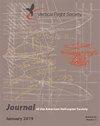尺寸不断增大的定距变转速四轴飞行器的悬停操纵特性
IF 1.4
4区 工程技术
Q2 ENGINEERING, AEROSPACE
引用次数: 1
摘要
在悬停状态下,模拟了固定螺距,变转速的四轴飞行器。考虑了三种飞机尺寸,转子直径分别为4,6和8英尺(1.2,1.8和2.4米),毛重分别为300,680和1200磅(136,308和544公斤)。使用CONDUIT®对每架飞机进行控制设计,首先使用标准ADS-33E-PRF处理质量规范。然后将弗劳德缩放应用于规格,以便为两架较小的飞机设计更具可比性,更具侵略性的控制器。在时域中模拟驾驶命令和阵风输入,以估计适当的局部悬停机动性所需的必要电机电流裕度。在所考虑的机动中,对于最小的飞机,偏航率步骤需要最大的电流余量,而纵向速度步骤需要最大的电流余量,而其他的,不管操纵质量指标的弗劳德缩放。使用这些模拟的最大电流值,300磅飞行器的电机重量占比为8.3-10.6%,680磅飞行器的电机重量占比为11.6-13.0%,1200磅飞行器的电机重量占比为15.8%。在较大的两架飞机上,通过俯仰轴和滚转轴只在姿态控制、姿态保持模式下飞行,而不是在平移速率控制模式下飞行,可以减少电机重量要求。在这种情况下,偏航率的阶跃命令对680磅重的车辆(10.7-11.8%的电机重量)是有限制的,而升力命令对1200磅重的车辆(13.6%的电机重量)是有限制的。估计电机重量的要求也减少了减少转子惯性和引入额外的过滤到飞机的命令。本文章由计算机程序翻译,如有差异,请以英文原文为准。
Hover Handling Qualities of Fixed-Pitch, Variable-RPM Quadcopters of Increasing Size
Fixed-pitch, variable-RPM quadcopters of increasing size are simulated in hover. Three aircraft sizes are considered, with rotor diameters of 4, 6, and 8 ft (1.2, 1.8, and 2.4 m) and gross weights of 300, 680, and 1200 lb (136, 308, and 544 kg) respectively. Control design is performed for each aircraft using CONDUIT®, first using standard ADS-33E-PRF handling qualities specifications. Froude scaling is then applied to the specifications in order to design more comparable, aggressive controllers for the two smaller aircraft. Piloted commands and gust inputs are simulated in the time domain in order to estimate the necessary motor current margins needed for adequate maneuverability local to hover. Of the maneuvers considered, a yaw rate step requires the highest current margin for the smallest aircraft, while the longitudinal velocity step requires the highest current margin for the others, regardless of the Froude scaling of the handling qualities metrics. Using the maximum current values from these simulations, the motor weight fraction is 8.3–10.6% for the 300-lb vehicle, 11.6–13.0% for the 680-lb vehicle, and 15.8% for the 1200 lb. Motor weight requirements can be reduced on the larger two aircraft by flying with the pitch and roll axes exclusively in the attitude command, attitude hold mode, rather than translational rate command. In this case, step commands in yaw rate are limiting for the 680-lb vehicle (10.7–11.8% motor weight fraction) and heave commands are limiting for the 1200-lb vehicle (13.6% motor weight fraction). Estimated motor weight requirements are also reduced by decreasing the rotor inertia and introducing additional filtering into the aircraft commands.
求助全文
通过发布文献求助,成功后即可免费获取论文全文。
去求助
来源期刊

Journal of the American Helicopter Society
工程技术-工程:宇航
CiteScore
4.10
自引率
33.30%
发文量
36
审稿时长
>12 weeks
期刊介绍:
The Journal of the American Helicopter Society is a peer-reviewed technical journal published quarterly (January, April, July and October) by AHS — The Vertical Flight Society. It is the world''s only scientific journal dedicated to vertical flight technology and is available in print and online.
The Journal publishes original technical papers dealing with theory and practice of vertical flight. The Journal seeks to foster the exchange of significant new ideas and information about helicopters and V/STOL aircraft. The scope of the Journal covers the full range of research, analysis, design, manufacturing, test, operations, and support. A constantly growing list of specialty areas is included within that scope. These range from the classical specialties like aerodynamic, dynamics and structures to more recent priorities such as acoustics, materials and signature reduction and to operational issues such as design criteria, safety and reliability. (Note: semi- and nontechnical articles of more general interest reporting current events or experiences should be sent to the VFS magazine
 求助内容:
求助内容: 应助结果提醒方式:
应助结果提醒方式:


